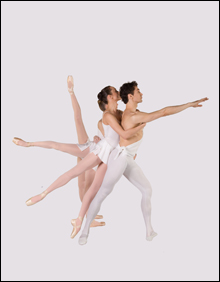
‘BEAUTIFUL IN ITS SIMPLICITY’ Mindaugas Bauzys, Vilia Putrius, and Lauren Kennedy in Apollo. |
There is a long list of reasons why George Balanchine is regarded as the greatest and most influential choreographer of the 20th century. He was a teenage choreographic prodigy, a young ballet master of the Paris-exiled Ballet Russes, and founder of the gold-standard New York City Ballet. As a dance creator, he was prolific and innovative, with a lyrical aesthetic and a rare musicality, a visual musician using beautiful bodies as his instruments.
All that will be on display November 6 and 7 at the VMA Arts & Cultural Center in Providence, as Festival Ballet presents its first all-Balanchine program, with four signature works by the master.
The program consists of Apollo (1928), Tschaikovsky Pas de Deux (1960), Tarantella (1964), and Who Cares? (1970).
The event is not as simple a matter as it sounds. Unlike with other choreographers' works, a dance company doesn't just choose what Balanchine pieces they like to do, schedule a program, and go about rehearsing. When it comes to these ballets, the dance company doesn't decide on the dances — the George Balanchine Trust decides on the dance company.
Based on what amounts to an audition tape, the Trust evaluates what pieces a dance company is capable of performing and then has an expert on the pieces, called a repetiteur, supervise rehearsals. Some ballets are simple enough for school programs, while others demand ultimate proficiency.
Asked which of these selections was the most difficult, Festival Ballet artistic director Mihailo "Misha" Djuric says that there are no easy pieces.
"This program they consider really challenging, really big," he said about getting permission. "This program has a lot of lyricism, slow movements where you have to show a lot of strength and control, and also very fast, quick movements, when you're dancing technically, where the movements are not mushy, they're clear, what the footwork is doing."
Djuric emphasizes that last point, that technique is at the service of "clarity of the movement, decision of the movement."
Consistent among Balanchine's choreographies is his musicality.
"He was really working with and conducting the dancers like a conductor is working with an orchestra," Djuric says. "So he was doing everything working from the score. Doing things on the right beat and the right count. The movement is very clear in Balanchine's work."
Comparing the finely tuned body of a great dancer to a musical instrument, he says, "There is the sound you can get from a Stradivarius violin and the sound you can get from a violin you can buy in any store."
Festival Ballet has performed works by Balanchine before, including part of Who Cares?, which is danced to songs of George Gershwin.
The technical skill required for the upcoming program is "amazing," Djuric says.
Take Apollo, for example, Balanchine's earliest surviving dance and the one which launched his acclaim. It is the signature dance of the New York City Ballet.
While it is "beautiful in its simplicity," Djuric remarks, sections are supremely difficult.